

| Well we spent 4 months in BA. We didn't really do very much. We visited a museum or two. We continued studying Spanish. But mostly we just lived like Porteños. We went to the shops - shops that had things we actually wanted to buy. We went to restaurants that had food we wanted to eat and wine we wanted to drink. Surely we couldn't still be in South America?? We met up with our Tenerife Spanish teacher, Christian now back home in Cordoba and working as a journalist. We met up with sailing friends René & Viola who had sailed south to BA, and also American sailing friends Chris & Jackie who had parked their boat in Ecuador and like us were cruising South America on land. They visited BA for a week so we took the opportunity (!!) to do the sights. Both couples had first been encountered in Rota in the winter of 2003. What a great introduction to the cruising community that had been. | |
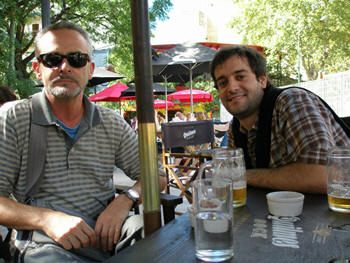 |
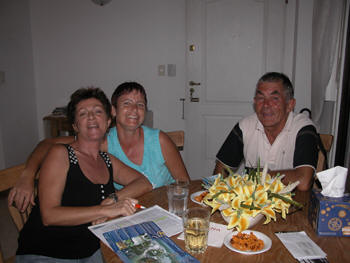 |
| But after 4 months of doing not very much we decided we really
ought to make an effort and go and see something more of Argentina and South
America. Though it was to prove even more difficult to leave than we
expected. As a first step we booked up a sort of Grand Tour of Argentina - Ushuaia on Tierra del Fuego, the glaciers at El Calafate and the falls at Iguazu. A couple of days before we were due to depart we noticed without much interest that some stubble burning fires north of the city had got out of control. The morning of our departure we discovered (with a great deal of interest) that the wind was now from the north, Buenos Aires was covered in smoke, and our airport was closed! We call the travel agent - "It's OK, planes are taking off, they're just not landing. Go to the airport." - "But if no planes are landing, there won't be any planes to take off" we point out. "You must go to the airport so that if there is a problem the airline can reallocate you - perhaps from Ezeiza ( the international airport)." With some scepticism we go to the airport. We have checked out of the apartment and left luggage with our friendly estate agent, so have to go somewhere! We arrive at the airport to find it predictably looking like those shots you see on the TV when the air traffic controllers have gone on strike during the peak holiday season. It's completely full, people are sleeping on their luggage. The announcement screens have given up and simply say "consultar", except there's not really any one to "consultar" as most of the operators have shutup shop and the few desks that are open don't know if or when there will be flights. There is one desk that is open and doing good business. It's the one for rescheduling flights. We join the very long queue and finally, and miraculously, are able to reschedule a flight for the following morning from the international airport. Our problem now is that we have nowhere to stay (along with several thousand other people). We taxi to the hotel we will be staying at for a few days when we return to BA. They are sympathetic, but full. They do though have a loft room, which they don't normally let, it's a little dark and of course the lift doesn't go that far, but if we like... Of course we like. What an opportunity to test two hernia repairs and heave our luggage up a steep narrow spiral staircase - perfect! Actually the room is charming. The hernia repairs are fine. And the following morning we're on the plane to Ushuaia. |
|
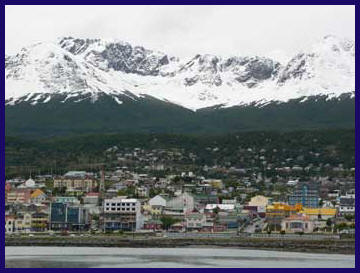 |
Ushuaia, what can we say? It's
desolate, it's drab, it's cold, it's windy and it rains every day.
Not all day, true, but every single day. Being built on the side
of the Beagle Channel it's also extremely steep - the map showed our
hotel as being only a few hundred metres from the centre of town, it
didn't show that those few hundred metres were almost vertical.
Ushuaia is expensive - absolutely everything has to be shipped in.
And finally it's a drab and ugly place - if you want to know what
happened to all those rusty old corrugated iron sheets that used to be
at the bottom of your garden, well they're in Ushuaia. Virtually
every building is roofed (and in many case built completely) in
corrugated iron. Plus points? Well there's the "Train to the End Of The World". This is a narrow gauge steam railway originally built by prisoners to service the penal colony here, but now a tourist attraction. It says quite a lot about Ushuaia that no prisoner ever successfully escaped. Most who tried died in the extremely uncompromising environment. The few who didn't die ended up returning to the prison which was infinitely better than trying to survive in the wild. Though miraculously the indigenous people seemed to survive quite happily until the Europeans wiped them out. |
| There's also the wildlife, mostly that's sea life. Seabirds run to millions, Penguins come in their thousands to breed - They had however left a few weeks before we arrived because by then it was too cold! But the sea lions were still there, lots of them and worth a boat trip for a better look. And finally there's centolla, the huge king crabs that breed in the channel and, if you take a mortgage to raise the funds, are absolutely delicious. |
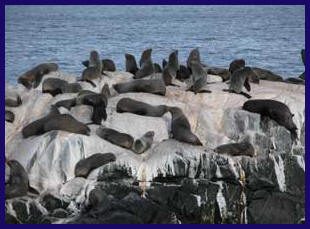 |
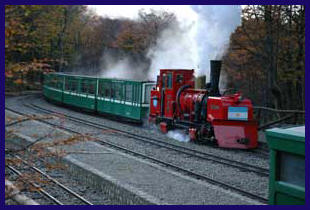 |
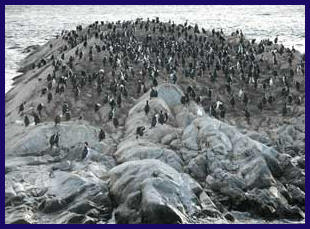 |
| So that was Ushuaia done. The best news about the place
was that we hadn't gone there in the boat. Now back on a plane and on our
way to:
El Calafate. The initial signs weren't encouraging. Our hotel was built on the old airport runway surrounded by a great deal of not very much. And that sort of described the inside of the hotel as well. It was modern, well furnished, but felt incredibly empty. It turned out to be Chinese owned, Chinese run and many of the guests were on Chinese package tours (which made for some interesting breakfast choices). It seems that the Chinese had spotted El Calafate as an investment opportunity, spotted the disused runway and were quite happy to build their hotel there and wait for the town to expand to meet it. The hotel didn't really do food except for breakfast. It said it did, there was a restaurant, a menu and things like that, but when we asked the waitress (/receptionist/cleaner/etc - the absence of staff contributed to the Marie Celeste feeling) if we could eat on our first night, her look of shock, confusion was so profound that we felt we had no choice but to go into town. She agreed this would be for the best and managed a weak smile. The hotel offered a free taxi service into town. We spoke to the manager/receptionist/porter who also turned out to be chauffer and off we went. El Calafate turned out to be a nondescript town made up of a mixture of tourist shops, a casino and bad overpriced tourist restaurants. We began to yearn for Ushuaia! |
| The following morning we were up at the crack of dawn. Barry breakfasted on stir-fried cabbage and glutinous rice. Lindy was more conservative. Then we're on a coach on our way to our first excursion "Patagonia Extrema"! This was to be a day of "trekking" on the Glaciers with crampons tied to our feet. The guy in the travel agent had talked us in to it. Barry was easily convinced, Lindy more sceptical. Now Barry too was having a few doubts. Glaciers are big and steep with crevasses. Almost everyone else on the bus looked young and fit. Barry was feeling older and frailer by the minute - perhaps a fake cardiac arrest was in order? |
 |
Actually it was fantastic. The trek had been obviously
designed to be achievable for middle aged sedentary types and most of the young
fit looking people turned out to be not that fit after all. Ben, an 11
year old from the US, turned out to be the most agile and impressively fearless
of the group (photo on the right). A small bonus reward at the end of the trek finished things off nicely! |
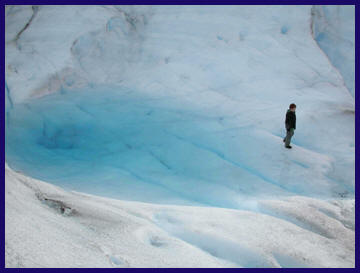 |
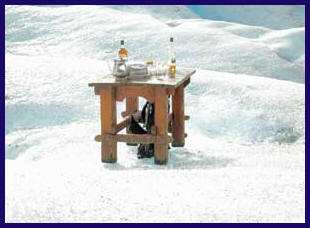 |
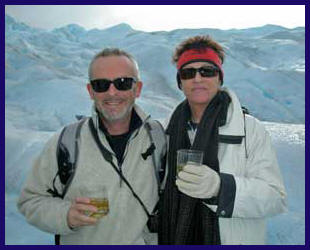 |
|
Most important of all, the Glacier "Perito Moreno" was amazing. The scale of the thing is almost incomprehensible. It's hard to see at this scale, but the small dot in the water in the picture on the right is a large tourist cruiser. And it's just one glacier, though one of the few that isn't in regression - global warming really comes home to you when you see the scale of these things up close and get some feel for the quantity of water released when one of them shrinks by a kilometer!! Under the surface of the water the ice is 60 metres deep. I forget how many cubic miles of water are locked in Perito Moreno, but it's a lot, and it just keeps creeping slowly down the valley at a couple of metres a day and out across the lake (it moves faster in the centre and slower at the sides because of friction, just like a river, and it turns out that ice is actually quite elastic and can cope with this). When it gets to the other side of the lake it hits the bank and can't go any further but all those cubic miles of ice keep on coming behind it. so it buckles up very slowly into a huge arch and then finally, every few months, the arch can't support any more pressure and it explodes! The following day we spent on the lake in a boat visiting the other glaciers. A completely different perspective, sitting on the water with the huge ice wall groaning above you and surrounded by icebergs. The bergs themselves were stunning. The most amazing shapes. And the colours - it's almost impossible to believe that white can be so blue. The pictures speak for themselves.
|
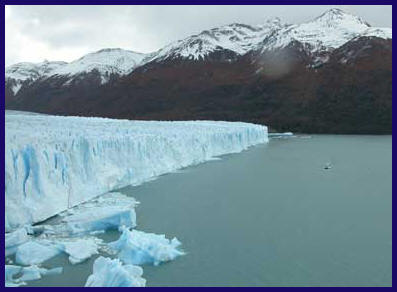 |
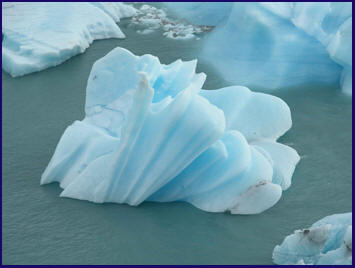 |
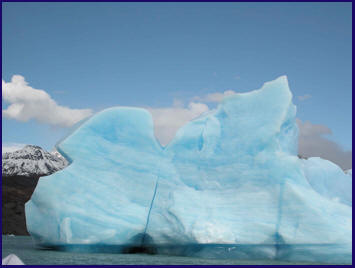 |
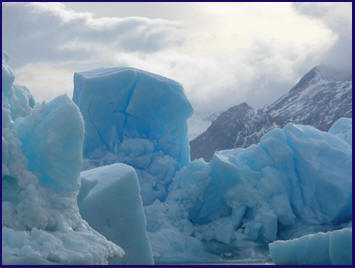 |
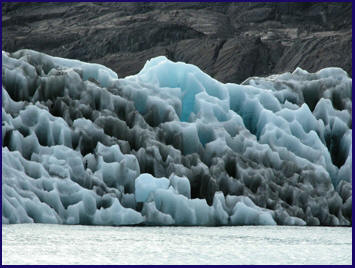 |
"Too many icebergs", you'll probably say. But you tell us - which ones should we delete? |
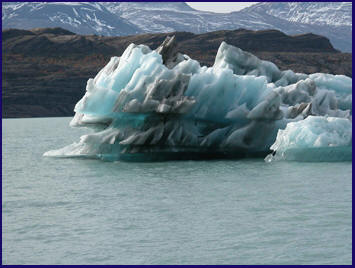 |
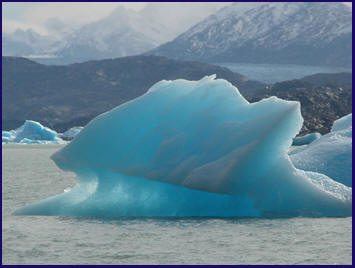 |
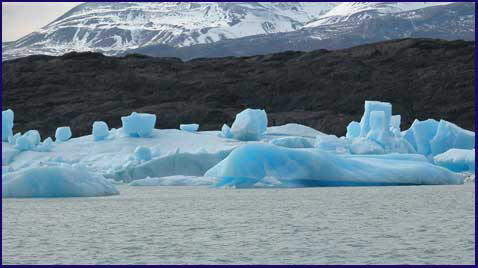 |
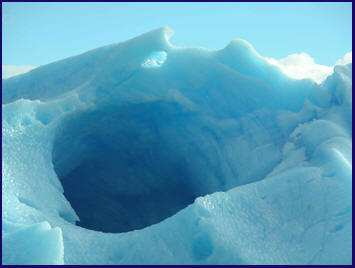 |
Back to Buenos Aires for a few days to change our luggage then off to Iguazu and the humidity of the rain forests. These amazing series of waterfalls separate Argentina, Brasil and Paraguay. Iguazu means "Big Water" in Guarani (the native language). If you ever visit you'll immediately realise that the Guarani have a real talent for understatement! There aren't really words to describe the grandeur and scale of this spectacle and the pictures hardly do it justice. We're working on including a short video in the next edition of the web, but in the mean time.... You'll just have to go - it really is worth the trip.
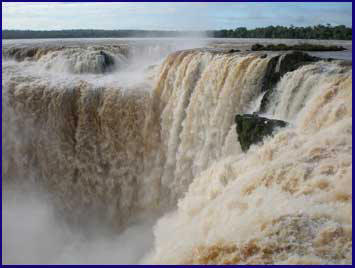 |
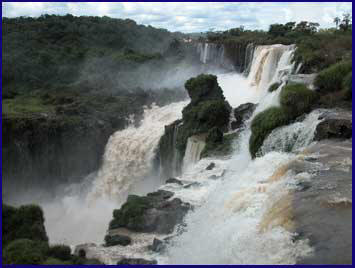 |
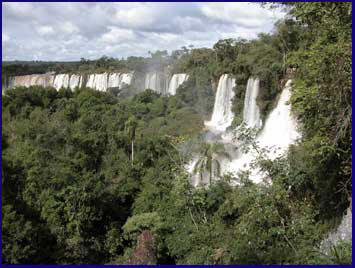 |
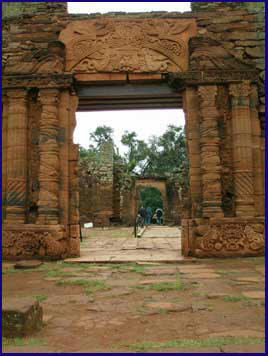 |
Incidentally, Iguazu was the real life location of the story in
the the film "The
Mission". The ruins of the actual Jesuit mission are still there, about a
days drive away and also worth a look. Impressive for a different reason,
mainly for having been built so far from anywhere with so little resources.
And before we return to BA for the final time a brief mention of coaties. These animals live in the forests around Iguazu and, just like the local people, have learnt the value of tourists. They have acute senses and can identify the smell or sound of a chocolate bar being unwrapped at 50 metres (you are continually warned not to eat in the park). The one you see below has been attracted by the sound of a wrapper being rustled in Barry's pocket. Cute though they look, they are burrowing animals, have immensely strong claws (not to mention cute but vicious little teeth) and can shred a rucksack. The next picture would show this sweet little thing taking his first flying lesson, dispatched by Barry's boot as it tried to demonstrate its shredding skills on his shoulder bag. He didn't even have any chocolate! |
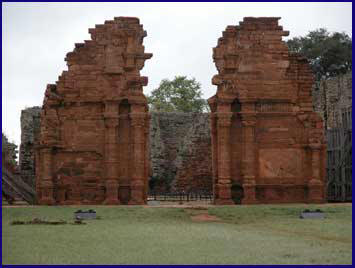 |
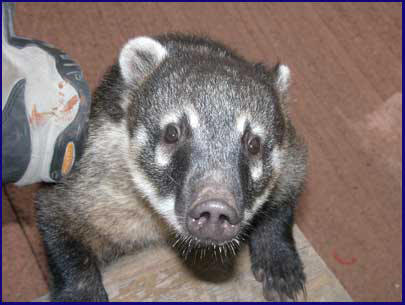 |
||
|
And for us, one more overnight stop in BA to collect luggage and sleep (no time for breakfast) then back to the airport to fly to Santiago de Chile. |